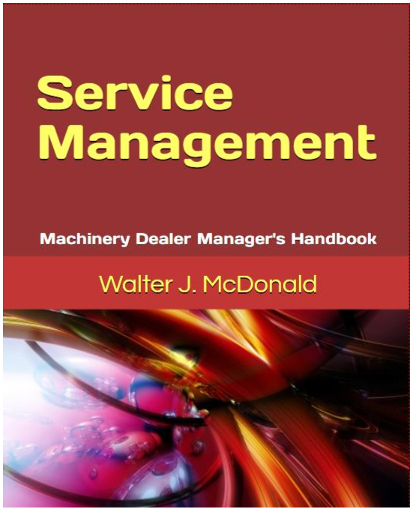A dealer VP of Aftermarket recently purchased my new 600-page Service Management—Machinery Dealer Manager’s Handbook. In my discussion with him, he stated his three priority issues were:
- How do I increase throughput?
- How do I decrease return service work?
- How do I decrease Work in Process?
Here are the recommendations I provided on how to address his three priority topics.
Step one is to identify quantitative performance benchmarks of highly successful dealers for each of these activities as well as relevant world-class best practices. (You now have them in the text.)
Step two is to measure and monitor your performance in each area.
Step three is to work on moving your operations up to the high-performance dealer level.
Priority Issue 1: How do I increase throughput?
In this text, throughput is called technician productivity. (For more details see Service Management: The Machinery Dealer’s Management Handbook, pages 125-224 and 466-473.)
Technician productivity has a major impact on overall dealer profitability and customer satisfaction. Productivity improvements add revenue and no incremental cost. And, most dealers who measure the value of lost time on an annual basis are shocked and surprised at how much incremental revenue is available, just through better management practices.
We have found it very useful to separate data for shop labor productivity from field service productivity. Each has different performance-inhibiting characteristics. But, the really big first place to start is off-shelf parts fill rate to service for your primary line(s). Then, track individual technician productivity weekly. In the text, you will have the opportunity to calculate the Approximate Annual Value of Lost Time.
Priority Issue 2: How do I decrease return service work?
In this text, it is called Rework. (For more details see page 132)
The Service Manager of a very large Caterpillar dealership showed me how he was working to improve their Rework from 1.8% to 1.5%. He performs a “cause analysis” on each repair order that is a rework event. He approached the problem from that of a coach, not a disciplinarian. He looked for the possible cause:
- Improper tooling.
- Poor workmanship.
- Inadequate Training.
- Failed part.
Then, he conducts the appropriate conversation with the responsible technician, seeking ways to help him improve his performance. If the Rework was caused by a failed part, this was a warranty issue and required no supervisory action.
Priority Issue 3: How do I decrease Work In Process?
Days in Work in Process (WIP) is a big profitability and cash flow issue. (For more details see page 130-131.) The elapsed time between opening a work order and receiving payment from the customer is called the cash conversion cycle. The longer the cycle, the more operating capital the dealer needs to pay current expenses. And, at current high-interest rates, this is very costly.
Start by mapping out the current work order process steps. Where are the big delays? Why? Some dealers use Post-it notes to chart the workflow on a conference room wall. They get everyone involved in the process to contribute to the assessment. Most do not understand what happens before they receive the work order or what happens afterward. Most do not understand the necessity for accuracy, prompt completion of their step, and efficient hand-off. And, we find some Service Managers are waiting until the end of the week to close out any work orders. Each of these delays further extends the cash conversion cycle.
Age work orders just like you would age receivables. Find out what is holding up closing the oldest repair orders. Reward the whole process team when you can demonstrate progress in reducing overall Days in Work in Process monthly.
Service Managers have huge challenges today with labor shortages and questionable work ethics of new hires. However, there are more useful Service management tools available today than ever before.
The big success secret for Service Managers is to become PARTNERS with your Parts Manager. Working with him/her to improve off-shelf parts fill rate to service for your primary lines to the mid-90% range will have an enormous impact on all aspects of your business. (But, you must still keep your eye on turns and obsolescence. All three have to be done well to succeed.)
For more information on how you and your Parts Manager can better collaborate to improve overall Aftermarket Operations, Profitability, and Customer Service, see details of my new Service Management text on my website:
https://www.mcdonaldgroupinc.com/equipment-dealer-training-books/service-management/ It’s ON SALE today.
I’d welcome your comments on this article: walt@mcdonaldgroupinc.com. I look forward to working with you on your dealership’s hot topics.

